
Strategy Execution and HR Governance
A strategy is only as good as its execution. HR plays a central role in turning plans into progress—if governance is done right.
Most strategic plans fail—not because of poor ideas, but because of poor execution. HR is uniquely positioned to close the execution gap by translating strategy into action, driving accountability, and designing the people systems that make progress possible.
What Is HR’s Role in Strategy Execution?
Execution is not just a management task. It requires:
- Right people in the right roles
- Aligned goals, performance, and rewards
- Supportive culture and communication
- Ongoing monitoring, adjustments, and governance
HR doesn’t just support execution—it orchestrates it through its influence on structures, behavior, and systems.
Governance: The Hidden Backbone
Governance defines how decisions are made, who is accountable, and what gets measured.
Key elements of HR governance include:
- Decision rights across HR and business units
- Clear role definitions (e.g. who owns talent strategy?)
- Policy frameworks and strategic guardrails
- Oversight bodies (e.g. HR Steering Committee, People Board)
- Escalation mechanisms for exceptions or conflicts
Strategy-to-Execution Cascade
Execution requires more than just alignment—it needs structure.
One effective model:
- Corporate strategy →
- Business unit strategy →
- HR strategy →
- People plans →
- Individual performance objectives
Each layer must have clear ownership, metrics, and feedback loops.
Operationalizing Execution
Practical ways HR supports execution include:
- Translating strategy into workforce plans
- Designing performance management aligned with strategy
- Integrating strategy into learning and development
- Embedding strategic goals into succession planning
- Creating dashboards to track execution progress
Risk and Control in HR Execution
Without good governance, HR execution can drift or conflict with broader priorities.
Risks include:
- Duplicated initiatives across units
- Shadow HR practices with no oversight
- Non-compliance with legal or ethical standards
- Mismatched accountability
Governance mitigates these by ensuring visibility, coherence, and discipline.
Example
In a multinational manufacturing firm, the strategy focused on cost reduction and digital transformation. HR supported execution by:
- Creating a strategic workforce plan focused on automation skills
- Embedding cost efficiency into goal-setting and incentives
- Launching an internal “digital academy”
- Setting up a governance council to track initiatives
Results were reviewed quarterly, and HR was treated as a strategic partner in business reviews.
Summary
Without execution, strategy is just a wish list.
Without governance, execution is chaos.
HR brings both structure and adaptability, helping the organization turn strategy into sustained results—through people, process, and purpose.